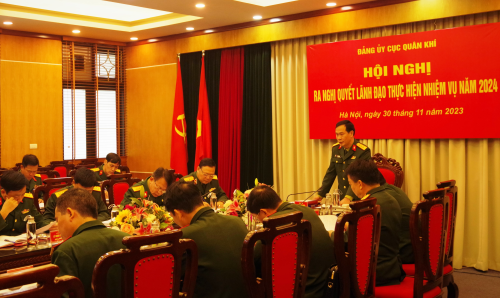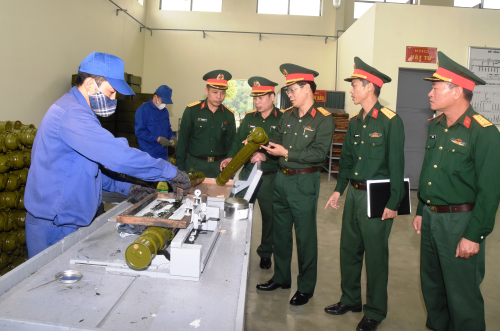Department of Ordnance focuses its leadership on renewing technical work to meet task requirements
Renewing technical work in general, weaponry-related technical work in particular is a task of importance and urgency. Therefore, the Party Committee and Command of the Department of Ordnance have focused their leadership and direction on taking practical, breakthrough measures to raise the quality of weaponry-related technical work to contribute to the building of an “adept, compact, strong” Army towards modernity.
 |
| Conference to issue the Resolution of 2024 by the Department’s Party Committee |
Grasping the Party’s military and defence viewpoints and guidelines as well as resolutions and directives by the Central Military Commission (CMC) and the Ministry of National Defence (MND) on leading technical work towards 2030 and beyond, over the years, the Department of Ordnance has proactively assisted the General Department of Technology in giving advice to the CMC and MND on weaponry-related technical work; at the same time, it has directed the comprehensive performance of this important work. As a result, weaponry-related technical work across the Military has been better maintained. The Ordnance Branch has been frequently consolidated in terms of organisational structure. The system of regulations and guiding documents on the Branch has been adjusted and closely supplemented. Technical facilities, depots, and stations have been planned and upgraded in a regular, uniform, safe way; their capabilities in repair, maintenance, and manufacture of weaponry and relevant technical materials have been improved. Great value has been attached to scientific research and technical training. The Branch has introduced a lot of reforms in researching, upgrading, and modernising weapons and technical equipment, thereby contributing to sufficiently, synchronously providing weaponry, military hardware, and ammunition for units across the Military.
A part from those above-mentioned positive results, the effectiveness of weaponry-related technical work has yet to be really high. There has not been a really major breakthrough in acquiring and upgrading weapons, military hardware, and ammunition; several units’ management work has yet to be close, thus leading to fire and explosion incidents. Currently, the building of an adept, compact, strong Army towards modernity is imposing higher task requirements on the Ordnance Branch. Meanwhile, the amount of weapons, military hardware, and ammunition is very large, and a considerable proportion of them have been in use for many years, thus posing safety risks to units. Moreover, the process of socio-economic development is threatening safety belts around technical facilities and arms depots. Against that backdrop, the Department’s Party Committee and Command decide to focus their leadership and direction on renewing weaponry-related technical work with proper, synchronous measures to improve the performance of their central political tasks and meet the requirements set by Army building and Fatherland protection in the new situation.
First of all, enhancing a reform in weaponry-related technical work in a synchronous, comprehensive, focalised manner. Grasping resolutions, directives, and plans by the CMC and MND on technical work, particularly the goals and requirements set in Plan 866/KH-BQP dated 21 March 2023 by the MND on implementing Resolution 1656-NQ/TW, the Department will concentrate on reviewing and supplementing targets and methods in its action plan/program for the Resolution to ensure the feasibility. At the same time, importance will be attached to researching and formulating guidelines, tasks, and measures for renewing weaponry-related technical work for the modernisation of the Military. In the medium term, the Department will give advice to higher echelons on consolidating and building an “adept, compact, strong, uniform” weaponry system across the Military, renewing technical management, operation, and support work for weapons, military hardware, and ammunition, and well implementing the Campaign titled “managing and exploiting weapons and technical equipment effectively, sustainably, safely, economically, ensuring traffic safety” (aka Campaign 50). It will direct offices and units to strictly maintain inspection to draw lessons, opportunely detect and settle weaknesses, and propose and apply modern technologies to weaponry-related technical work. Besides, it will enhance political and ideological education to render all cadres, employees, and soldiers fully aware of the important role of weaponry-related technical work, raise their responsibility for weaponry management, maintenance, repair, and utilisation, and encourage “industriousness, thrift, dedication, courage, good preservation, sustainable use” as the basis for realising the goal of renewing and improving weaponry-related technical work.
 |
| Inspecting repair work at Workshop X265 |
Second, attaching importance to planning the system of arms depots and repair facilities, building an “adept, compact, strong, uniform”, efficient, effective Department of Ordnance. The Department will continue to work with offices and units to adjust and consolidate the organisational structure of the military weaponry force properly at each level. Grounded on lessons learnt from adjustments in its affiliated technical facilities’ organisational structure, the Department will direct other affiliates to continue to review and complete their working regulations, and supplement functions and tasks of each speciality, particularly in the offices and units that are subject to merger and adjustment. It will frequently carry out inspections to detect and opportunely deal with shortcomings as the basis for the efficient, effective operation of logistics-technical boards of its grass-roots level affiliates. Besides, offices and units within the Department will be prepared for the merger of relevant General Departments in a close, serious manner. The Department will continue to give advice and directions on realising the planning of the system of arms depots and repair facilities under Project KA-10 as well as on implementing the 2023 Law on Management and Protection of Defence Works and Military Zones.
Grounded on the planning and consolidation of offices and units, the Department will continue to review, adjust, and supplement regulations on delegating and decentralising the management and operation of weaponry-related technical work in accordance with each speciality’s functions and tasks, while closely cooperating with offices and units in managing specialised weapons. It will actively apply information technology to commanding, operating, and managing technical work, digitalising the management of technical equipment, and completing a database as the basis for carrying out a digital transformation in technical work and building an e-Government in the management and operation of weaponry-related technical work.
Third, renewing and improving weaponry-related technical support in accordance with the road map for Army modernisation. Currently, the demand for using weapons, military hardware, ammunition, and explosives in training, exercises, and combat readiness across the Military is enormous. Hence, the Department will better decentralise technical support and closely combine on-the-spot support with mobile repair and application of new technology to management, maintenance, and repair. Adhering to the guidelines on procurement, manufacture, innovation, and modernisation of guns, military hardware, and ammunition, basing on technical facilities’ capacity, the Department will continue to effectively implement projects/programs to invest in technology and upgrade all-level repair facilities, with priority given to tactical-level units and those performing their tasks in sea, island, key areas. It will strictly maintain regularity building in weaponry-related technical work and improve its capacity to master technologies for repairing guns, military hardware, and ammunition. While raising technical facilities’ capacity, it will focus on building the weaponry-related technical posture in each region and key area.
Furthermore, the Department will cooperate with competent offices in researching, building, and piloting technical models and modes of technical support for new-generation guns, military hardware, and ammunition to draw lessons and apply those models and modes across the Military. It will continue to propose the application of Defric, Nano, and CLP technologies to preserving and sealing up infantry weapons. It will direct weaponry offices at all levels to enhance inspection of regular technical support for weaponry; its stations, workshops, and arms depots will strictly maintain technological procedures and safety regulations, follow “5S” standards, and build a regular, modern working environment.
Fourth, actively renewing forms and methods of implementing Campaign 50, promoting all forces’ synergy to raise the quality of weaponry-related technical work. Under the line on “comprehensively raising the quality of Campaign 50, making a new breakthrough in mastering modern weapons and technical equipment and ensuring safety in a proactive, creative manner towards sustainable development”, the Department will focus on leading and directing weaponry offices and facilities to develop their content, targets, and measures of implementation properly, with emphasis placed on raising the quality of weaponry-related technical work. To deeply, practically develop the Campaign, the Department will direct offices and units to build and multiply “role models” and “typical units”, align the Campaign with the Determined to Win Emulation Movement and other ones, and step up the study and following of Ho Chi Minh’s ideology, ethics, and lifestyle as well as the Campaign titled “promoting tradition, devoting talent, deserving to be Uncle Ho’s Soldiers in the new period”. It will continue to bring into play its models, such as “youth’s depot”, “20 October depot” (women’s depot), “youth’s self-management of technical day”, and “scientific and technical youth team”. Doing so will enable the Department to mobilise all forces’ synergy and promote self-reliance, innovation, and creativity among collectives and individuals in renewing weaponry-related technical work, meeting the requirements of Army building and Fatherland protection in the new situation.
Col. HA DINH DIEP
Secretary of the Department’s Party Committee
Deputy Director of the Department